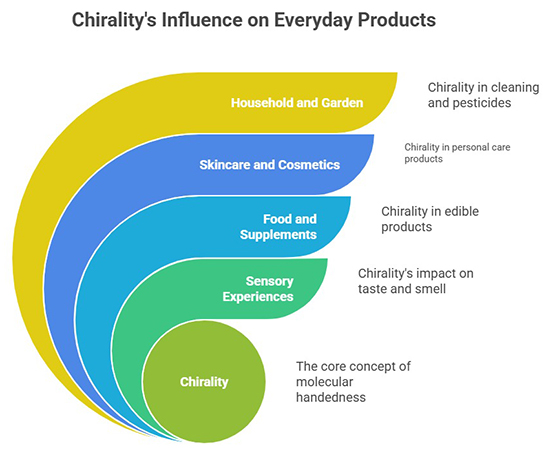

Ever notice how your left and right hands look similar but aren't exactly the same? Molecules can be like that too. This unique trait, called chirality, quietly influences many of the products we use every day—often in ways we don't realize.
Chirality (pronounced ky-ral-ity) means a molecule has a “handedness”—it comes in two mirror-image forms, known as enantiomers. They're made of the same stuff, but they behave differently, especially when it comes to how they interact with our bodies and our senses.
So where do we encounter chirality in everyday life? Turns out, pretty much everywhere.
Let's start with something as simple as smell. Take limonene, a common molecule in citrus-scented products. One version of limonene smells like fresh oranges; the other smells more like pine. Same molecule, different orientation—completely different scent. This is why perfume makers pay close attention to chirality when designing fragrances.
The same concept applies to taste. A famous example is spearmint and caraway—both contain carvone, but each uses a different enantiomer. One tastes minty, the other tastes spicy. It's wild how a tiny molecular twist can change your whole taste experience.
Chirality matters in food science too. Many sweeteners, vitamins, and amino acids are chiral. Sometimes only one version is useful—or safe. One enantiomer might taste sweet, while its twin could be bitter, tasteless, or even harmful. That's why manufacturers carefully choose which version to include in what you eat or drink.
Your favorite skincare serum? It might contain lactic acid or retinol, both of which have chiral forms. One version may soothe your skin and boost radiance, while the other could be less effective—or more irritating. Using the right “hand” of the molecule can make all the difference in how a product performs.
Pesticides, herbicides, and cleaning agents also get a chirality check. In many cases, only one enantiomer does the job—whether it's killing weeds or breaking down grime. Using just the active version means better results and less waste, which is good for us and the environment.
So why does this tiny detail of molecular handedness matter? Because in the world of chemistry, mirror images aren't always equal. One version of a molecule might be helpful or pleasant, while the other does nothing—or worse, causes problems. Understanding chirality helps manufacturers make smarter, safer, and more effective products.
It's a perfect reminder that even the smallest things—molecules included—can make a big difference in our lives.